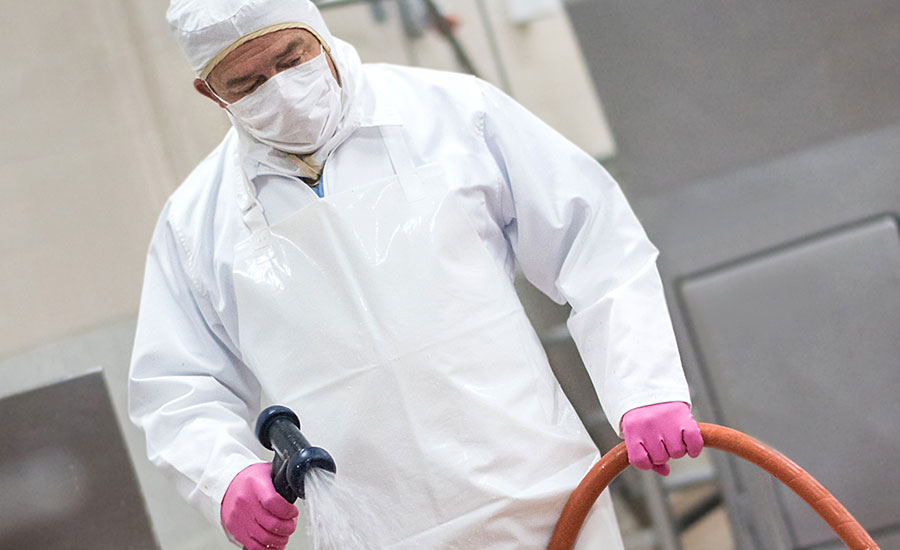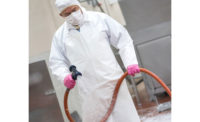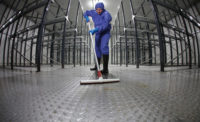Cleaning meat and poultry plants can be hazardous.
With many workers using potentially dangerous chemicals to sanitize facilities and machinery, the prospect of sickness or injury looms. Employees who mishandle materials or fail to use the proper personal protective equipment (PPE) are at risk for a host of ailments, ranging from burns to respiratory issues, analysts note.
Table of Contents
Among the potentially hazardous chemicals are products containing alkyl dimethyl benzyl ammonium chlorides (BACs) and other quaternary ammonium compounds (QACs) that plants use for cleaning and disinfection, reports the New York-based Mount Sinai Selikoff Centers for Occupational Health and the Bellevue/NYU Occupational and Environmental Medicine Clinic.
Exposure to QACs can result in contact dermatitis, trigger asthma symptoms, and cause eye and mucous membrane injuries and oral and gastrointestinal ailments, the organizations report.
“Many worker injuries are from chemical reactions when mixing materials,” says Frankie Wood-Black, principal of Sophic Pursuits Inc. — a Ponca City, Okla.-based environmental consulting firm — and the director for process technology in the Division of Agriculture, Science and Engineering at Northern Oklahoma College in Tonkawa. “Combining bleach and ammonia can produce a toxic gas that burns the lungs.”
Alkaline and chlorinated compounds, as well as acids and even hot water can pose safety threats, with respiratory injuries often resulting from the release of gases and vapors because of improperly mixed chemicals, says Larry Keener, president and chief executive officer of Seattle-based International Product Safety Consultants LLC.
In addition, workers who inhale gases can lose consciousness, putting those who handle potentially dangerous equipment in further peril, he says.
A plethora of data
An important initial step in safeguarding workers is to make the employees aware of all potential threats and the actions they can take to minimize incidents, Wood-Black says. That includes studying the usage guidelines and risk factors that are listed on chemical packages, as well as the safety data sheets (SDS) for each product, she says.
The U.S. Department of Labor’s Occupational Safety and Health Administration (OSHA) requires that a chemical’s manufacturer, distributor or importer provide an SDS for each hazardous chemical to downstream users that communicate information on the threats.
The SDS includes such data as the properties of each chemical; the physical, health, and environmental hazards; protective measures; and safety precautions for handling, storing and transporting the chemical. Information in the SDS must be in English, though sheets can include facts and figures in other languages as well.
It also is critical that workers wear the appropriate PPE, Wood-Black says, which may include goggles, masks, gloves, face shields, rubber boots and coveralls. “The PPE is the last line of defense for the worker,” she says.
Most companies have requirements for PPE use with rubber aprons that cover most of the worker’s body, which is vitally important, says Norman Marriott, emeritus professor in the College of Agriculture and Life Sciences at Virginia Polytechnic Institute and State University (Virginia Tech) in Blacksburg.
“There is little risk to workers if they wear the necessary PPE, handle the chemicals properly and ensure that the chemicals they are using have the right concentration and temperature,” he says. “But chemical use can be hazardous or even fatal if the products have too much strength or employees do not follow the necessary operating guidelines.”
While chemicals pose a potentially significant safety hazard to meat and poultry plant workers who sanitize facilities and equipment, chemical use largely remains essential for reducing or eliminating pathogens in processing areas.
The Food and Agriculture Organization (FAO) of the United Nations reports chemical cleaning solutions are very effective because removing loose dirt and meat/fat residues with water alone isn’t effective in cleaning meat and poultry facilities.
“Efficient meat plant cleaning and sanitation is often neglected as it requires extra work and the positive effects are not immediately visible,” the FAO reports. “However, failures in meat plant hygiene can cause high financial losses in the long run. Unhygienic conditions in a meat plant result in unattractive, tasteless products; spoilage of valuable food; and/or foodborne diseases.”
The FAO notes cleaning and sanitation are two of the most important activities in the meat plant, “as these measures provide the necessary environment for proper meat handling and processing,” and proper cleaning and sanitation is increasingly important in meat processing as more perishable and hygienically sensitive meat products come on the market. The microbial load of products such as prepacked portioned chilled meat, vacuum-packed sliced sausage and ham products and meat in controlled-atmosphere packaging must be low to guarantee adequate shelf life and to avoid spoilage during distribution, the FAO reports.
“Disinfectants should be effective and rapidly acting in killing microorganisms,” the FAO adds, stating the chemical composition will vary in accordance with the specific target, such as a slaughterhouse or meat processing facility, and by the distinct chemical formulations of each disinfectant manufacturer’s products.
While mixing chemicals can be dangerous, the FAO notes disinfectants are mostly mixtures of different chemical substances, and that combinations of disinfection chemicals “achieve a synergistic effect and result in the elimination of a broader spectrum of microorganisms.”
— Richard Mitchell
To minimize incidents, it is essential for meat and poultry plant operators to provide detailed instructions to workers on all facets of chemical handling, analysts say.
Marriott says effective training vehicles can include seminars, webinars, videos and online programs, and that it is crucial for instruction to be ongoing because of the typically high worker turnover in meat and poultry plants. It also helps prevent longer-term employees from becoming complacent.
Plant operators can gauge workers’ comprehension and monitor whether they are following safety protocols through observation and testing, he says. A company’s sanitation supervisor or quality assurance leader typically is accountable for the employees’ performance.
“Meat and poultry processors are responsible for providing adequate training, as well as for all consequences and liabilities,” Keener says. “Companies need to put the onus on the supervisors who are properly compensated and can be counted on to show up for work every night. It is their responsibility to make sure the transient portion of the workforce is adhering to protocols and procedures.”
Yet, he notes it is a challenge for companies to maintain a completely knowledgeable workforce, particularly because “many employees quit as soon as better job alternatives emerge where they do not have to work with dangerous chemicals and machinery or on the third shift.”
He says workers should be made aware of all hazards and risks from chemical handling, which will enable them to better identify symptoms from exposure. Instruction also should detail the measures employees should take when a colleague suffers chemical-related injuries or illnesses, including evacuation procedures, Keener says.
In addition, learning how to interpret information on containers is essential, he says. The contents and hazard level of the materials, the possibility of explosions, and the potential for caustic and inhalation injuries are particularly important to understand.
“Training is huge as just about all of the sanitation chemicals that companies use in meat and poultry plants are potentially dangerous,” Keener says.
Room for improvement
Despite the importance of having first-rate training programs, Keener says meat and poultry processors’ chemical safety initiatives often are inadequate.
“Many processors are not doing the best job possible,” he says. “Training is fundamental and companies need to be more effective in mitigating workplace injuries by giving a greater focus to sanitation.”
Among the common program weaknesses is the inability of some safety trainers to address employees in their native languages, Keener says. Having a large base of transient workers also makes it difficult for all cleaning crew members to receive the latest information.
Keener recommends plant operators hold seminars in multiple languages in which instructors stress the importance of accurately mixing chemicals, and offer rudimentary chemistry lessons that illustrate the consequences of improper mixing.
“Training is fundamental and companies need to be more effective in mitigating workplace injuries by giving a greater focus to sanitation.”
— Larry Keener, International Product Safety Consultants LLC
To enhance comprehension, sanitation leaders also should provide hands-on guidance with newer workers during the employees’ initial handling of chemicals, he says.
The most effective results will occur when supervisors spend most of their day on plant floors monitoring employees’ actions, Keener says, and that operators can further enhance surveillance by dividing the cleaning staff into teams and have team leaders observe the workers in his or her group.
Encouraging workers to observe their colleagues and call out improper chemical handling behavior will also strengthen plant and worker safety, he says.
“Employees that are acting incorrectly place the entire cleaning crew at risk,” Keener says. “It is not just the worker who is lax in following protocols and procedures that will suffer from a mishap.”
Plants can further enhance safety by only allowing workers to perform those tasks for which they were given specialized training, says Jen Allen, vice president of operations and engineering for Allen Safety LLC, an Orlando-based global safety and process improvement company.
“A high number of people can be affected if something goes wrong and the plant is gassed out,” she says, noting an entire facility is at risk from potentially deadly or catastrophic leaks that are the result of incorrect chemical handling and mixing.
Chemicals that are not properly mixed, titrated or diluted can be particularly hazardous, she says, and incidents often occur when employees become numb to such risks.
“Operators must be careful not to mix or use multiple sanitizers at once,” report’s Canada’s National Collaborating Center for Environmental Health. “For instance, mixing ammonia and sodium hypochlorite solutions produce chloramines, while mixing sodium hypochlorite and acid solutions, such as vinegar, can produce chlorine gas.”
Additional episodes also can result when the chemical concentrations far exceed the levels of protection workers get from PPE and plant ventilation systems, Allen says. Skin burns often occur when employees do not wear or clean their PPE correctly, or choose not to use specific pieces of equipment, she says.
A never-ending quest for safety
“It also helps to ensure that chemicals are being used in the manners in which they were intended by suppliers,” Allen says. “This will result in assuring that skin and respiratory hazards are properly identified, reduced and eliminated, and that proper procedures and personal protective equipment can be implemented and included in training modules.”
It is vital, meanwhile, for plant operators to share relevant case studies and data on the injuries and illnesses that happen in their facilities with workers as a reminder to employees they should not be complacent, she says, adding that hands-on instruction is typically the most effective training method.
“Hazards are always present and it will be only a matter of time before a significant injury occurs if employees cut corners, relax or become complacent with the handling processes they are following or their use of proper personal protective equipment,” she says.
Even workers who typically handle chemicals properly can become safety risks because of complacency, Keener says.
“An overfamiliarity can lead to big mistakes, so all workers must periodically undergo retraining,” he says. “Vigilance by the meat and poultry processor is the real answer to the issue.” NP





Report Abusive Comment